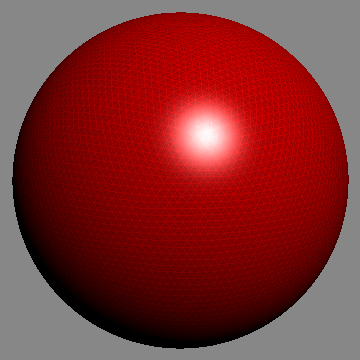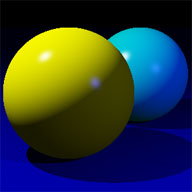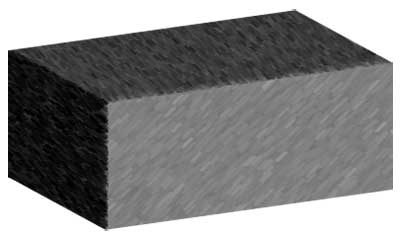|
Gouraud Shading
Gouraud shading, named after Henri Gouraud, is an interpolation method used in computer graphics to produce continuous shading of surfaces represented by polygon meshes. In practice, Gouraud shading is most often used to achieve continuous lighting on triangle meshes by computing the lighting at the corners of each triangle and linearly interpolating the resulting colours for each pixel covered by the triangle. Gouraud first published the technique in 1971. Description Gouraud shading works as follows: An estimate to the surface normal of each vertex in a polygonal 3D model is either specified for each vertex or found by averaging the surface normals of the polygons that meet at each vertex. Using these estimates, lighting computations based on a reflection model, e.g. the Phong reflection model, are then performed to produce colour intensities at the vertices. For each screen pixel that is covered by the polygonal mesh, colour intensities can then be interpolated from th ... [...More Info...] [...Related Items...] OR: [Wikipedia] [Google] [Baidu] |
D3D Shading Modes
D3D may refer to: * DIII-D (tokamak) (pronounced 'D3D'), a tokamak located at San Diego, California * Direct3D, Microsoft's graphics rendering scheme * Dolby 3D * Duke Nukem 3D ''Duke Nukem 3D'' is a first-person shooter video game developed by 3D Realms. It is a sequel to the platform games ''Duke Nukem'' and ''Duke Nukem II'', published by 3D Realms. ''Duke Nukem 3D'' features the adventures of the titular Duke Nuke ... or Duke3d, a first person shooter video game from 1996 * China Railways HXD3D, a type of electric locomotive in China {{Letter-NumberCombDisambig ... [...More Info...] [...Related Items...] OR: [Wikipedia] [Google] [Baidu] |
Shading
Shading refers to the depiction of depth perception in 3D models (within the field of 3D computer graphics) or illustrations (in visual art) by varying the level of darkness. Shading tries to approximate local behavior of light on the object's surface and is not to be confused with techniques of adding shadows, such as shadow mapping or shadow volumes, which fall under global behavior of light. In drawing Shading is used traditionally in drawing for depicting a range of darkness by applying media more densely or with a darker shade for darker areas, and less densely or with a lighter shade for lighter areas. Light patterns, such as objects having light and shaded areas, help when creating the illusion of depth on paper. There are various techniques of shading, including cross hatching, where perpendicular lines of varying closeness are drawn in a grid pattern to shade an area. The closer the lines are together, the darker the area appears. Likewise, the farther apart the lin ... [...More Info...] [...Related Items...] OR: [Wikipedia] [Google] [Baidu] |
Blinn–Phong Reflection Model
The Blinn–Phong reflection model, also called the modified Phong reflection model, is a modification developed by Jim Blinn to the Phong reflection model. Blinn–Phong is the default shading model used in OpenGL and Direct3D's fixed-function pipeline (before Direct3D 10 and OpenGL 3.1), and is carried out on each vertex as it passes down the graphics pipeline; pixel values between vertices are interpolated by Gouraud shading by default, rather than the more computationally-expensive Phong shading. Description In Phong shading, one must continually recalculate the dot product R \cdot V between a viewer (''V'') and the beam from a light-source (''L'') reflected (''R'') on a surface. If, instead, one calculates a ''halfway vector'' between the viewer and light-source vectors, : H = \frac R \cdot V can be replaced with N \cdot H, where N is the normalized surface normal. In the above equation, L and V are both normalized vectors, and H is a solution to the equation V=P_H(-L) ... [...More Info...] [...Related Items...] OR: [Wikipedia] [Google] [Baidu] |
List Of Common Shading Algorithms
{{Short description, none This article lists common shading algorithms used in computer graphics. Interpolation techniques These techniques can be combined with any illumination model: * Flat shading * Gouraud shading * Phong shading Illumination models Realistic The illumination models listed here attempt to model the perceived brightness of a surface or a component of the brightness in a way that looks realistic. Some take physical aspects into consideration, like for example the Fresnel equations, microfacets, the rendering equation and subsurface scattering. Diffuse reflection Light that is reflected on a non-metallic and/or a very rough surface gives rise to a diffuse reflection. Models that describe the perceived brightness due to diffuse reflection include: * Lambert * Oren–Nayar (Rough opaque diffuse surfaces) * Minnaert Specular reflection Light that is reflected on a relatively smooth surface gives rise to a specular reflection. This kind of reflection is especial ... [...More Info...] [...Related Items...] OR: [Wikipedia] [Google] [Baidu] |
Mach Bands
Mach bands is an optical illusion named after the physicist Ernst Mach. It exaggerates the contrast between edges of the slightly differing shades of gray, as soon as they contact one another, by triggering edge-detection in the human visual system. Explanation The Mach bands effect is due to the spatial high-boost filtering performed by the human visual system on the luminance channel of the image captured by the retina. Mach reported the effect in 1865, conjecturing that filtering is performed in the retina itself, by lateral inhibition among its neurons. This conjecture is supported by observations on other (non-visual) senses, as pointed out by von Békésy. The visual pattern is often found on curved surfaces subject to a particular, naturally-occurring illumination, so the occurrence of filtering can be explained as the result of learnt image statistics. The effect of filtering can be modeled as a convolution between a trapezoidal function that describes the illuminat ... [...More Info...] [...Related Items...] OR: [Wikipedia] [Google] [Baidu] |
Graphics Processing Unit
A graphics processing unit (GPU) is a specialized electronic circuit designed to manipulate and alter memory to accelerate the creation of images in a frame buffer intended for output to a display device. GPUs are used in embedded systems, mobile phones, personal computers, workstations, and game consoles. Modern GPUs are efficient at manipulating computer graphics and image processing. Their parallel structure makes them more efficient than general-purpose central processing units (CPUs) for algorithms that process large blocks of data in parallel. In a personal computer, a GPU can be present on a video card or embedded on the motherboard. In some CPUs, they are embedded on the CPU die. In the 1970s, the term "GPU" originally stood for ''graphics processor unit'' and described a programmable processing unit independently working from the CPU and responsible for graphics manipulation and output. Later, in 1994, Sony used the term (now standing for ''graphics processing unit'' ... [...More Info...] [...Related Items...] OR: [Wikipedia] [Google] [Baidu] |
Diminishing Returns
In economics, diminishing returns are the decrease in marginal (incremental) output of a production process as the amount of a single factor of production is incrementally increased, holding all other factors of production equal ( ceteris paribus). The law of diminishing returns (also known as the law of diminishing marginal productivity) states that in productive processes, increasing a factor of production by one unit, while holding all other production factors constant, will at some point return a lower unit of output per incremental unit of input. The law of diminishing returns does not cause a decrease in overall production capabilities, rather it defines a point on a production curve whereby producing an additional unit of output will result in a loss and is known as negative returns. Under diminishing returns, output remains positive, however productivity and efficiency decrease. The modern understanding of the law adds the dimension of holding other outputs equal, since ... [...More Info...] [...Related Items...] OR: [Wikipedia] [Google] [Baidu] |
Specular Highlight
A specular highlight is the bright spot of light that appears on shiny objects when illuminated (for example, see image on right). Specular highlights are important in 3D computer graphics, as they provide a strong visual cue for the shape of an object and its location with respect to light sources in the scene. Microfacets The term ''specular'' means that light is perfectly reflected in a mirror-like way from the light source to the viewer. Specular reflection is visible only where the surface normal is oriented precisely halfway between the direction of incoming light and the direction of the viewer; this is called the half-angle direction because it bisects (divides into halves) the angle between the incoming light and the viewer. Thus, a specularly reflecting surface would show a specular highlight as the perfectly sharp reflected image of a light source. However, many shiny objects show blurred specular highlights. This can be explained by the existence of microfacets. W ... [...More Info...] [...Related Items...] OR: [Wikipedia] [Google] [Baidu] |
Phong Shading
In 3D computer graphics, Phong shading, Phong interpolation, or normal-vector interpolation shading is an interpolation technique for surface shading invented by computer graphics pioneer Bui Tuong Phong. Phong shading interpolates surface normals across rasterized polygons and computes pixel colors based on the interpolated normals and a reflection model. ''Phong shading'' may also refer to the specific combination of Phong interpolation and the Phong reflection model. History Phong shading and the Phong reflection model were developed at the University of Utah by Bui Tuong Phong, who published them in his 1973 Ph.D. dissertation and a 1975 paper.Bui Tuong Phong, "Illumination for Computer Generated Pictures," Comm. ACM, Vol 18(6):311-317, June 1975. Phong's methods were considered radical at the time of their introduction, but have since become the de facto baseline shading method for many rendering applications. Phong's methods have proven popular due to their generally e ... [...More Info...] [...Related Items...] OR: [Wikipedia] [Google] [Baidu] |
Flat Shading
Shading refers to the depiction of depth perception in 3D models (within the field of 3D computer graphics) or illustrations (in visual art) by varying the level of darkness. Shading tries to approximate local behavior of light on the object's surface and is not to be confused with techniques of adding shadows, such as shadow mapping or shadow volumes, which fall under global behavior of light. In drawing Shading is used traditionally in drawing for depicting a range of darkness by applying media more densely or with a darker shade for darker areas, and less densely or with a lighter shade for lighter areas. Light patterns, such as objects having light and shaded areas, help when creating the illusion of depth on paper. There are various techniques of shading, including cross hatching, where perpendicular lines of varying closeness are drawn in a grid pattern to shade an area. The closer the lines are together, the darker the area appears. Likewise, the farther apart the line ... [...More Info...] [...Related Items...] OR: [Wikipedia] [Google] [Baidu] |
Pixel
In digital imaging, a pixel (abbreviated px), pel, or picture element is the smallest addressable element in a raster image, or the smallest point in an all points addressable display device. In most digital display devices, pixels are the smallest element that can be manipulated through software. Each pixel is a sample of an original image; more samples typically provide more accurate representations of the original. The intensity of each pixel is variable. In color imaging systems, a color is typically represented by three or four component intensities such as red, green, and blue, or cyan, magenta, yellow, and black. In some contexts (such as descriptions of camera sensors), ''pixel'' refers to a single scalar element of a multi-component representation (called a ''photosite'' in the camera sensor context, although ''sensel'' is sometimes used), while in yet other contexts (like MRI) it may refer to a set of component intensities for a spatial position. Etymology The w ... [...More Info...] [...Related Items...] OR: [Wikipedia] [Google] [Baidu] |




